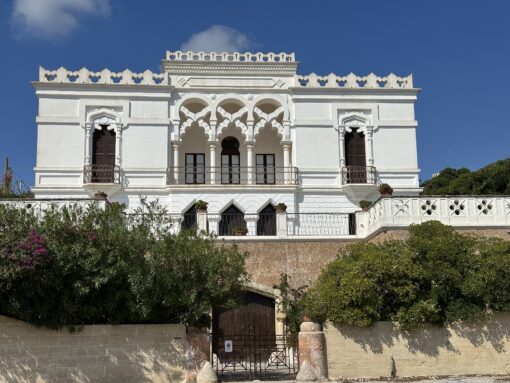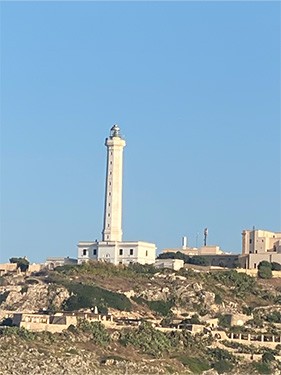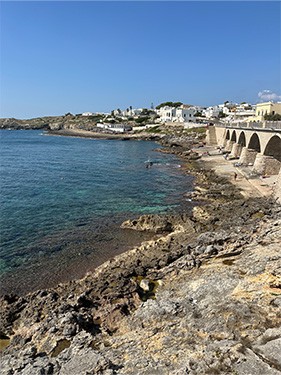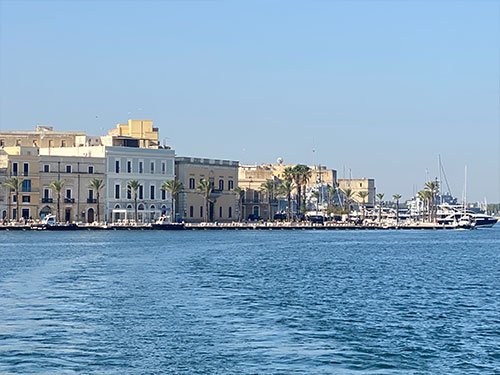Ciao Italia
The limited attractiveness of southern Italy quickened our pace. We lengthened our day trips and shortened the number of stops. From Crotone we left Calabria in the morning in complete darkness and headed for Apulia, 75 nm away, at the heel of Italy, between the brightly lit Luna A and B oil rigs. Ka still suffering from back spasm.
Apart from 4-5 visits by the speedboats of the Guardia de Finanza – something like the Italian customs – who obviously wanted to see if we had illegal immigrants on board, it was an uneventful crossing. As before in the whole Mediterranean, the weather was either very windy or totally calm. Again, we only had winds up to 8 knots and the mainsail was only up for decoration purposes.
Santa Maria de Leuca
We moored in the marina of Leuca (pronounced L(e)-U-Ka) and found a very special little town. Of the 1,500 inhabitants, most probably live in mini-castles. Along the shore road are numerous small palaces, in the eclectic architectural style, as the municipality calls it. It really is a splendour, the villas surrounded by park-like gardens in relaxed peace and serenity.




Leuca living
In the evenings, the locals are strolling on the Corniche and share their experiences with a lot of gestures. Nice restaurants and bars invite you to visit right on the waterfront. Around the town one can find numerous grottos, in the clear sea water. At weekends, locals take small boats with picnic baskets to the caves and anchor for a few hours. It’s all very picturesque. And to make the idyll perfect, a lighthouse towers above everything, living up to its name, the second highest in Italy. The church of Santa Maria de Finibus, where Pope Benedict once gathered his fans and read mass, also stands on the mountain.



Sights from Leuca
The name Leuca is said to come from a siren of dubious character. The addition of Santa Maria is not because Petrus is said to have landed here on his way to Rome. Rather, Santa Maria herself is said to have saved several fishermen from certain death at sea. The town’s name was extended in her honour. So it’s a mixture of dubious siren and divine virgin. In Italy, anything is possible.



Leuca grottos
The city in the perfect location was already populated in the Palaeolithic Age, as findings prove. Today, rich Italians from inland use the little harbour town as a weekend domicile. We didn’t really see any tourists, Leuca seems to be a purely Italian affair. For sailors, the place is perfect for a stopover either on the way to Greece or to the Adriatic. Smugglers probably see it that way too, because there were plenty of impounded smugglers’ vessels in this harbour as well.
Provisioning for sailors are not easy to get. There is a small shop and a not particularly well-equipped supermarket 3 km away. On the other hand, the mooring prices are fair, electricity and drinking water as always in Italy is included. However, there are only a limited number of berths for guests. In the high season, it is probably much more difficult to get a berth.
Turning into the Adriatic
We enjoyed the unexciting ambience for a few days before leaving the Ionian Sea and heading “around the corner” into our 5th Mediterranean Sea, the Adriatic. Continuing in the absence of good anchorages along Italy’s rocky south-east coast, marinas dictated our route. In Otranto there was no room for a catamaran. San Foca wanted to take us in. However, the harbour master was probably very optimistic, because the width of our designated berth was easily 3-4 feet too small. After a bit of “casino”, we cut the mooring lines of our neighbouring boat at the harbour master’s behest, in order to somehow get to the dock with a lot of squeezing and pushing. Ka still had to get into the water to remove the numerous, useless lines from our rudders.
Not a good start and we didn’t want the guys to rearrange the harbour because of us. So in the morning we set off on the 30 nm journey to Brindisi.
Brindisi
In the small city (87 thousand inhabitants) the boats of our friends Ruth&Michael and Walter were ready for winter lay-up. In 2015 we all were moored at the same jetty in Valencia. We have been friends ever since. Michael had arranged a place for us at the jetty of a shipyard. It was a nice reunion after all these years, but we were always in constant contact.
Brindisi is a military port and there were several NATO warships moored in the 3.5 nm long and well protected bay. The most beautiful part of the city is the waterfront area, but there is not much to see at all.



Brindisi waterfront
Visiting Lecce
We were much more interested in Lecce, the city in the interior. We boarded the train and in 30 minutes we were in what is probably the most beautiful small town (95,000 inhabitants) I have ever seen. A pearl in white. The old town is a feast for the eyes and a sensation for church lovers. There is a magnificent church almost every 100 metres, which is surpassed by the next even more magnificent church after a few metres. The cityscape is characterised by the light-coloured limestone quarried near Lecce. You hardly get tired to see enough of the houses, palaces and ancient Roman sites. In between on can find plenty of restaurants and cafés, for much needed walking breaks. We enjoyed some “Leccese” coffees. A speciality that is said to exist only here: iced coffee with ice cubes on sweet almond milk. Very refreshing on hot days, of which we had caught one.






Beauties of Lecce
With aching feet but delighted by the beauty and charm of Lecce, we got back on the train to Brindisi. And that was it for Italy. Ahead of us lay the crossing of the Adriatic and our last post-season journey: 120 nm to Montenegro. Ciao Italia. / Holger Binz

